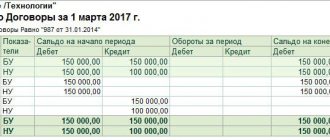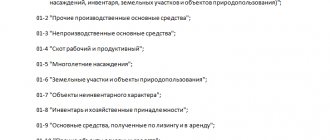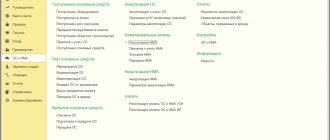22.10.2018
In this article we will look in detail at step-by-step instructions on how to correctly record and write off materials in 1C 8.3 from account 10. The choice of document for accounting for materials depends on the purpose of this write-off:
- In order to transfer both your own and customer-supplied materials into production or operation, you must use the “Requirement-invoice” document. Examples of such goods and materials are office supplies, auto parts, various small business products, materials for construction, etc.
- In the case when you need to write off materials that have become unusable, or are actually missing, but are listed in the program, you need to use the document “Write-off of goods”.
The loss of materials is written off as a transaction loss
The following articles talk about the nuances of inventory:
- “Inventory of inventories: order and nuances”;
- “Procedure for conducting an inventory of fixed assets”;
- “The procedure for carrying out a BSO inventory (nuances).”
To understand the postings for writing off shortages during inventory, we will use the conditions of the example.
After conducting an inventory at warehouse No. 3 (the financially responsible person is storekeeper Zavyalov N.
InfoS credit account 94 they can be written off:
- for production or sales costs;
- against the culprit with compensation from his earnings or by paying him the amount of the loss to the company’s cash desk;
- in other expenses.
Write-off of shortage within normal limits
Shortages within the limits of natural loss are written off as production or sales costs. Write-offs are carried out from accounts intended for recording material assets into expenses by type of production, using account 94:
- Dt 94 Kt 10 (41, 43..);
- Dt 20 (23, 44..) Kt 94.
By analogy with shortages, the write-off of losses from defects is reflected in the accounting entry in the debit of accounts 20, 23, 29, etc.
and account credit 28, depending on in which production they are identified: main, auxiliary, servicing.
Objects under repair are also reflected separately; an inventory report of unfinished repairs in the INV-10 form is filled out for these fixed assets.
Objects that are listed in the organization, but do not belong to it, for example, those that are in custody, are entered into separate matching statements.
All inventory documents are certified by the signatures of financially responsible persons and members of the commission headed by the chairman.
The final results of the inventory of fixed assets are entered into the statement of results, form INV-26.
OS inventory accounting
The results of the inventory are subject to immediate reflection in the accounting records of the enterprise.
How to legally dispose of inventory
In the life of an entrepreneur, many problems of various kinds arise. One of them is the problem of inventory balances. Why can an organization have inventory balances, and most often problematic, “virtual” ones? As a rule, these are the following cases: the purchase of a non-existent product, the sale of a product for unofficial cash payment, and simply the sale of a product that is not properly documented with primary documents. The result is the same: the goods hang on the organization’s balance sheet. “Legs are growing” and on the old topic - the search for cash.
There are various ways to solve this problem. I will dwell on some of them in more detail.
Method “through write-off”:
The application of the first method occurs by writing off the remainder of any product for the economic needs of the organization. Let’s assume that an organization is engaged in the procurement of timber; it also often purchases ASG (for “cash” purposes). Let's say a company decides to stop illegal connections or put its accounting in order. The purchased ASG can be written off as being used, for example, in the construction of forest roads at the entrance to the plot or for strengthening and backfilling a timber warehouse. In this case, it will be quite difficult for tax authorities to verify the reality of the write-off and the very fact of purchasing the ASG. In addition, it is unlikely that tax officers will go deep into the forests to inspect access roads. Simply put, this method works if you have specific objects for the purpose of writing off such inventory balances as ASG, and besides, it can be used repeatedly. The disadvantages of the scheme are that proper documentary support is required (this is not a minus, but a natural need for any method of getting rid of inventory), and those very specific objects that can be written off are needed.
The "natural" method.
The write-off of inventory balances can be made for completely legitimate reasons - natural loss. What is natural decline? The answer to this question is normatively fixed - “the permissible amount of irrecoverable losses from shortages and (or) damage to inventories.” Natural loss can occur during drying, shaking of the product, when it becomes damp and for other technical and natural reasons. Loss rates for each type of product by industry are provided for by regulations of the relevant department. For example, natural loss in food products is regulated by Order of the Ministry of Industry and Trade of Russia dated March 1, 2013 N 252 “On approval of norms for natural loss of food products in the field of trade and public catering.” In addition to the fact that, based on the above acts, the accountant has the right to write off cases of real loss, in this way you can “cover up” a little loss that you need to get rid of.
The specific method is “Promotion!” Hypothetically, getting rid of inventory for some types of products can be organized by announcing a so-called promotion - “when you buy... such and such a product as a gift.” In this case, the gift will be a unit of inventory. There are a lot of “buts” here. Unlike the stated topic of the article, this method is semi-legal. In fact, you will not give anything to anyone. For special persuasiveness, indeed, you can give something, but every other time (by the way, in this way you can really veil the fictitiousness of this action). This method will not work in every area of business; for example, its use is logical in the retail trade of certain types of goods. It is unlikely that you will be able to give away any complex mechanisms or auto parts as gifts, but, for example, when selling food, this is possible. In addition, I believe that this is a method for extremely infrequent use.
Features of accounting for shortages and losses
When reflecting shortages and damage, a number of rules must be taken into account.
Reflecting shortages
Shortages can only be recorded when they are discovered:
- when carrying out inventory;
- upon receipt of objects in volumes limited by the supply agreement.
On the DT account, the shortage is recorded in the following amounts:
- Real cost if the values cannot be restored or do not exist at all.
- Residual value, if the question concerns fixed assets that are out of order or missing.
- Real losses if partial damage occurs.
That is, the accounting amount is determined depending on the specific circumstances.
Write-off
The write-off is carried out on CT account 94. In the process, they are included in the cost structure.
The accounting entry was written off as a loss of materials.
Usually, employees with whom agreements on full financial responsibility have been concluded are responsible for shortfalls in the response. Let's say a warehouse worker.
Employees whose fault caused shortages are required to compensate for material damage to the company.
Attention: This is directly stated in paragraph 1 of Article 243 of the Labor Code of the Russian Federation.
The employee responsible for the shortage can cover the damage by depositing money into the company's cash register. Another option is that the company and the employee agreed that the accounting department will withhold funds from upcoming salaries.
In this case, do not forget about the restriction: the amount of withheld funds should not exceed 20 percent of the salary. If the damage is greater, you will have to provide the employee with an installment plan.
In any case, take a statement from the employee in which he writes that he agrees to compensate for the damage and within what time frame.
If the employee refuses to compensate for the damage, the company has the right to go to court. Important: Then in the transactions, instead of account 73, account 76 “Settlements with various debtors and creditors” is used.
Tax accounting for shortfalls is somewhat simpler - in it the amount of the shortfall is considered a non-operating expense, and the compensated damage is fully attributed to non-operating income (letter of the Ministry of Finance of Russia dated October 14, 2010 No. 03-03-06/1/648).
But in the case where the manager decides not to recover damages from the guilty person, the amount of the shortfall cannot be written off as expenses. For these purposes you will have to spend your net profit.
When compensation for damage is made at the expense of the employee, the manager issues an appropriate order.
Manager of Romashka LLC Lopatkin O.G.
Knocked a can of paint over a box of printer paper, rendering it unusable. Lopatkin admits his guilt and is ready to reimburse the book value of the paint in the amount of 300 rubles. and paper in the amount of 200 rubles.
They can be written off as other expenses. In this case, this wiring is performed: DT91/2 KT94. The entry is relevant when the amount of losses exceeds the norms of natural profit. If the person responsible for causing the damage is found, recovery occurs. In this case, the following wiring is relevant: DT73/2 KT94. If a shortage is detected within the EU boundaries, it is written off at the expense of cost. Record used: DT20, 44 KT94.
If a shortage is discovered upon acceptance of goods and materials, it makes sense to act on the basis of the provisions of the agreement. The agreement, as a rule, stipulates the maximum amount of shortages. If losses are made within these values, they are reflected in account 94.
Company assets can be lost as a result of force majeure (flood, drought, earthquake) or stolen by thieves who cleverly cover their tracks.
First, the property owner must understand the true reasons for the shortage and take measures to find the perpetrators, as well as evidence of their involvement in the loss of valuables. To do this, the company can conduct an internal investigation itself or file a complaint with the police.
Let's look at an example to see what kind of postings are used when writing off a shortage if the culprit is not identified.
Construction materials worth RUB 2,654,399 disappeared from the construction site.
38 kopecks
Registration and approval of results Accounting reference Bringing accounting data into compliance with actual availability. Write-off of shortages or capitalization of surpluses
Reasons for conducting an inventory, in addition to the annual obligation, may be:
- Change of financially responsible person;
- Fact of theft or damage;
- Disaster;
- Organizational reasons (change of manager, reorganization, etc.):
Get 267 video lessons on 1C for free:
- Free video tutorial on 1C Accounting 8.3 and 8.2;
- Tutorial on the new version of 1C ZUP 3.0;
- Good course on 1C Trade Management 11.
The results of the inventory can be:
To carry out an inventory at the enterprise, a commission consisting of at least three people is formed.
And those that are not associated with emergency events.
Due to emergency events
Deficiencies arising as a result of force majeure events are included in accounting as other expenses.
In this case, make the following entries:
DEBIT 94 CREDIT 41 – reflects the cost of missing goods;
DEBIT 91 subaccount “Other expenses” CREDIT 94 – the cost of missing valuables is written off as other expenses.
Losses resulting from extraordinary events should be written off as material expenses in tax accounting. But first, be sure to obtain written confirmation from the authorities that force majeure actually occurred. For example, a certificate from the Ministry of Emergency Situations.
Due to the employee's fault
But usually, excess shortages are not associated with extraordinary events. Accounting for shortages depends on whether there are those responsible for them.
Let's consider typical accounting entries for writing off shortages of materials identified during the inventory.
How to reflect shortages of materials as a result of inventory
To carry out the inventory, a special inventory and a commission are created that will conduct the event. Inventory can be carried out in warehouses or inside any premises.
Postings:
Account Dt Account Kt Description of posting Amount of posting Document-basis 94 10.01 Identification of shortage of materials Amount of shortage Inventory list INV-3
Matching sheet INV-19
Accounting certificate-calculation
Postings for loss of materials within normal limits
Some finished products tend to decrease in weight or volume.
Step-by-step instruction
On February 6, the following office materials were transferred to the accounting department for general business needs:
- paper “Snow Maiden” - 30 pcs.;
- hole punch - 3 pcs.;
- calculator - 3 pcs.
The organization’s accounting policy for accounting and accounting regulations establishes a method for writing off materials at average cost.
Let's look at step-by-step instructions for creating an example. PDF
| date | Debit | Credit | Accounting amount | Amount NU | the name of the operation | Documents (reports) in 1C | |
| Dt | CT | ||||||
| Write-off of materials for general business needs | |||||||
| 06 February | 26 | 10.01 | 9002,35 | 9002,35 | 9002,35 | Write-off of materials | Request-invoice |
| Adjustment of the cost of written-off materials to the weighted average cost | |||||||
| 28th of February | 26 | 10.01 | -175,77 | -175,77 | -175,77 | Adjustment of the cost of written-off materials to the weighted average cost | Closing the month - Adjusting the cost of an item |
Reasons for leaving
Disposal of intangible assets listed in the organization may occur for the following reasons:
- expiration of a certificate, patent or other documents that confirm the company’s right to use intangible assets;
- unsuitability of the asset for further use;
- transfer of an intangible asset to the authorized capital of other business entities;
- gratuitous transfer of intangible assets;
- sale of these assets.
Note 1
In accordance with the 22nd paragraph of Accounting Regulation 14/2000, the value of intangible assets that are no longer used for the purposes of producing products, providing services, performing work or to meet the management needs of the organization is subject to write-off.
In parallel with the write-off of the residual value of intangible assets, the amount of accumulated depreciation is also subject to write-off, if this amount was previously reflected in accounting in the accounting account $05$ “Depreciation of intangible assets.”
Can not understand anything?
Try asking your teachers for help
Income and expenses received as a result of writing off intangible assets:
- reflected in the accounting records of the organization in the reporting period to which they relate;
- are included in the financial results of the organization.
The instructions for using the Chart of Accounts indicate that when writing off intangible assets, their value should be reduced by the amount of depreciation charges accrued during the period of operation, if depreciation was recorded on account $05$ “Depreciation of intangible assets.” This is reflected in accounting by the following entry:
- Debit $05$ “Amortization of intangible assets”
- Credit $04$ “Intangible assets”
The residual value of the disposed intangible assets is written off using the following entry:
- Debit $91-2$ “Other expenses”
- Credit $04$ “Intangible assets”
The balance of the $91$ “Other income and expenses” account is calculated every month by comparing debit and credit turnover. Then $91-9$ is written off from the subaccount to the $99$ “Profit and Loss” account.
Calculation example
Nedra LLC placed an order for 1000 pcs. facing tiles for interior work in the amount of 20,000 rubles.
After payment for the goods, 990 pieces were actually delivered. in the amount of 19,800 rubles.
To calculate the permissible amount of damage for which the seller who sent the cargo is not responsible, we refer to the approved standards.
The acceptable loss percentage is 1.8.
1000pcs. (paid tiles) x 1.8/100 = 18 pcs.
It turns out that within the permissible limits (taking into account the possibility of combat) 18 pieces may be missing.
In fact, the shortage amounted to 1000 pieces - 990 pieces. = 10 pcs.
It should be noted that if the ceramics were sent in containers, bags, cassettes, the percentage of natural losses is less - 1.35.
Note. Before new regulations are put into effect, previously approved norms are applied, therefore many are relevant from the times of the Soviet Union.
Disposal due to expiration of useful life
At the moment an intangible asset is accepted for accounting, the company determines its useful life. After this period, the intangible asset must be written off from accounting. The basis for writing off an intangible asset is an act drawn up by a specially organized commission, its composition determined by the head of the organization.
Based on the drawn up and signed act on the write-off of an intangible asset, which is approved by the head of the company, the object is written off from the register. This fact is recorded in the Intangible Asset Accounting Card.
Depreciation is accrued on an intangible asset in accordance with PBU 14/2000 and stops from the first day of the month that follows the month of repayment of the full cost of the intangible asset.
Example 1
The company owns an intangible asset. Its initial cost is $18,000 rubles excluding VAT. The useful life at the time the object was accepted for accounting was set at five years and ends in December of the current year. The amount of depreciation charges for the period of operation of an intangible asset in the account $05$ “Amortization of intangible assets” as of November $30 of the current year is equal to $17,700$ rubles. Thus, in December of the current year, the accountant must make the following accounting entries:
Picture 1.
Rules for writing off inventory items
Inventory assets mean the following property of the organization:
- raw materials - items, things that are used in production for the manufacture of any product;
- work in progress - goods, products, the production of which has not been completed, which have not received consumer properties in accordance with their purpose, that is, those that are in the production stage;
- finished products - goods that can be sold without additional costs, having gone through all stages of production established in the relevant regulatory documents: regulations, technical instructions;
- inventories - unused property of an organization transferred for storage to warehouses.
Both the person responsible for the safety of valuables and keeping records of them, as well as the chief accountant or the head of the enterprise, can propose recycling. In order to carry out write-offs, a special commission is created in the organization, which can act on both a temporary and permanent basis. The composition of such a commission must include persons who are financially responsible for specific assets of the company, specialists in specific equipment, and the chief accountant. The powers of the commission include, inter alia, drawing up a write-off act, a sample of which is presented below.







